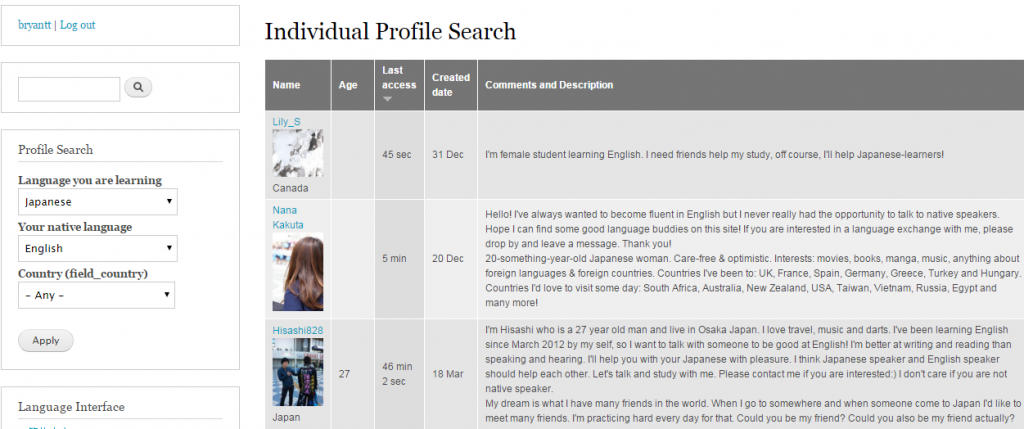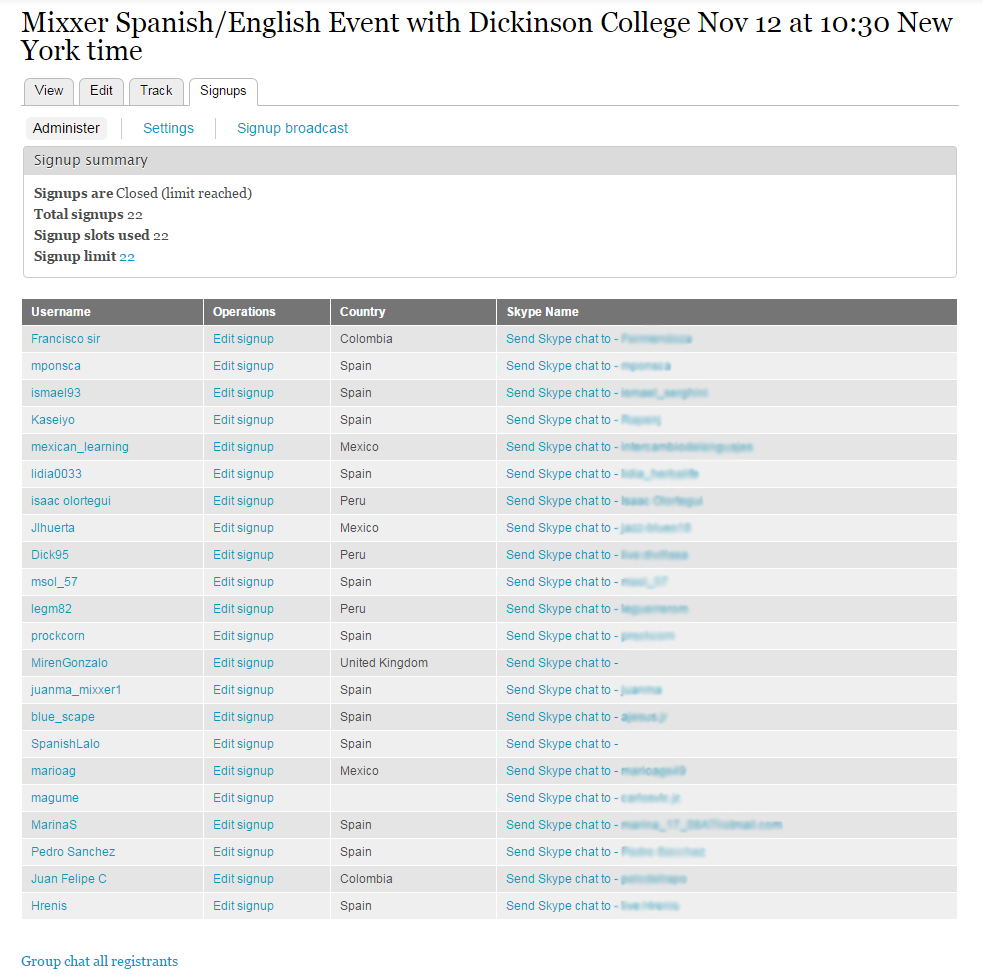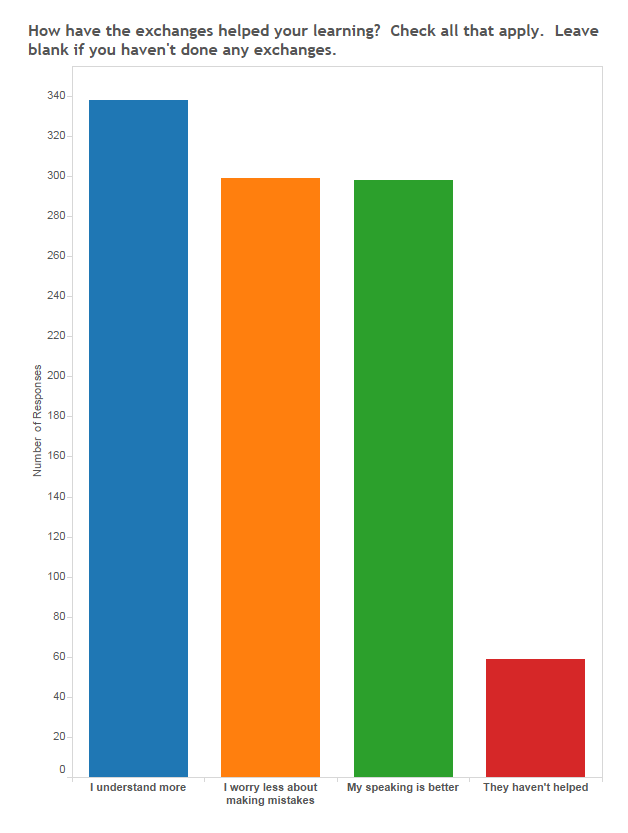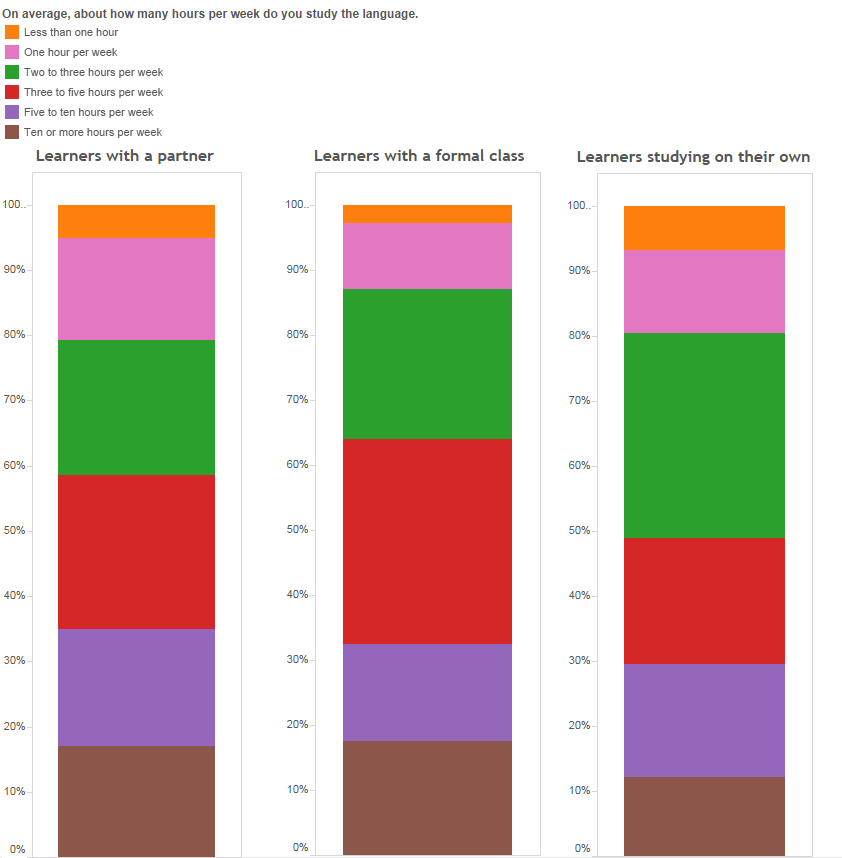Connect your Students with Native Speakers Today
 By Todd Bryant, Language Technology Specialist, Dickinson College.
By Todd Bryant, Language Technology Specialist, Dickinson College.
There has been extensive research on the effectiveness of language exchanges, also referred to as “telecollaboration”, “tandem learning” or “Virtual Immersion”, as a method to promote cross-cultural awareness and language development (Belz, 2002; Thorne, 2006; Ware, 2008). Technical advances have made communicating with others around the world via text, voice and video for free extremely common as well. Skype, the largest voice over IP service, reached one third of all international phone traffic in 2012 and continues to grow at the expense of traditional carriers. Despite these advances, classes that integrate real-time communication with native speakers are still clearly more the exception than the rule.
At Dickinson College, we first tried to organize exchanges for our students by looking for class-to-class partnerships with other institutions abroad. With our own study abroad programs, we figured we were in a better position than most to find contacts, but we were largely unsuccessful. While there were some technical difficulties, by far the greater problem was organizational. Initially finding potential partners was time consuming, and very few partnerships even began once each side compared time zone differences, semester schedules, class sizes, and lab availability. For those telecollaboration projects that did start, continuing them became difficult as the professors and course times changed each semester. More often than not, one side or the other cancelled the partnership after the first or second semester citing primarily issues of time but also reliability of the other side.
THE MIXXER
To help solve this problem, we created “The Mixxer”. The Mixxer is a free social networking site for language learners. Users specify their native language and the language(s) they would like to practice when they register. They can then search for partners based on their languages and contact them. Once they’ve agreed on a day and time, most users then connect via Skype.

Teachers and instructors have three options for connecting their students with language partners: find another teacher for a class to class partnership, have students find their own partners on the site and connect outside of class, or use the ‘event’ feature to connect their students with native speakers during a lab hour. Because of the problems mentioned above, all of our classes use one of the latter two options to connect our students with individual learners who have registered on the site.
We have found that students in some of our intermediate and advanced students are able to do the exchanges as homework. These students are assigned to create their own profile on the site, find a partner, contact them via Skype and then write a paragraph or two summarizing their exchange and reflecting on what they learned. The advantage to this approach is that no additional class time is needed and students can choose their own partner. The disadvantage is that this requires some initiative and perseverance on the part of the students. While most are fine, a few usually complain that they were unable to find a partner or that their partner did not show up at the agreed upon time. To avoid this, we instruct students to contact multiple potential partners and to start doing so well in advance. Finding a partner should never be very difficult for native English speakers, as the balance is heavily tipped in their favor with a far greater number of English learners than native speakers on the site. Still, it is necessary to schedule the exchange far enough in advance so that another exchange can be scheduled in case of a cancellation or other problem.
By far our most common approach is to use the “event” function on the Mixxer. An event is little more than a sign-up sheet sent to individual language learners with a matching language profile asking if they would be interested in speaking with our students at a given day and time. We limit the number of native speakers who can register to avoid having more native speakers attend than we have students in the class. Last semester 21 sections of Spanish, Portuguese, Russian, German, French and Japanese used this method to connect our students with native speakers during their lab hour. On the day of the exchange, the instructor sends out a group Skype chat to the native speakers who signed up. The Skype names of those who respond are given to a student in the class, and the student then calls their partner. Since attendance rates vary, any student without a partner joins into a three person call. The ability to organize an event is available to any teacher who registers on the site, and there are instructions provided as well. The benefit is that every student is assured a partner. The structure is by necessity very limited. The only “rule” is that the first 25 minutes is spent speaking the target language of our students and next 25 minutes in English. Our students come prepared with conversational questions that usually reflect the vocabulary or a cultural point they have covered in class. We do not require that learners from the Mixxer site prepare anything in advance. They usually simply continue the conversation into the English portion, though it may change if their language level is significantly higher, which is often the case.

LEARNER PERCEPTIONS
The event feature allowed us to offer any class a lab hour for students to do exchanges. However, their popularity grew based on accounts from instructors of how they were received by students. Our professors never needed convincing that their students would benefit linguistically from communicating with a native speaker on a regular basis, but until we started implementing the exchanges, I don’t think any of us were aware of the positive impact it could have on a class. Professors who had done the exchanges remarked on the increased energy in the classroom leading up to the exchanges as students anticipated communicating with a native speaker for the first time. Because students have no knowledge of the person with whom they’ll be speaking, they need to prepare questions appropriate for any country and for different ages. Formulating these questions is also a very engaging class activity during one of the days leading up to the exchange. Our instructors have also reported an increased confidence among the students after they have seen that they can communicate effectively in the target language for 25 minutes with only one or two semesters in the language.
To determine if I could find evidence of learners perceiving their learning differently due to language exchanges, I surveyed Mixxer users on January 4th, 2016. The survey was sent to all native speakers and learners of English ages 20 and over who had created accounts on the site between April 2014 and May 2015. These users, if they were able to find and connect with a partner on the site, would have been involved in what I call individual exchanges, meaning they would have joined our events, or more likely, they would have found a partner on their own and spoken with another user on the site via Skype. Like our students, these learners would have been offered very little if any guidance. Some of these users are taking a formal course and supplementing their learning with the exchanges, though the majority are independent learners trying to improve their language skills on their own.
One of the questions meant to measure whether learners felt the language exchanges had improved their learning, if at all. From the total of 755 respondents, 601 said they had done at least one exchange, and we can see they were encouraged by the results. Only 59 said they didn’t feel the exchanges had helped, while the remaining 542 selected on average two of the three positive potential outcomes. Improved understanding was the most often selected by 47% of the respondents, while improved speaking and worrying less about mistakes were nearly equal at 41%.

In addition to finding the exchanges encouraging, Mixxer users who had participated in exchanges also reported increased confidence speaking in the target language. Anecdotally, increased confidence had been apparent by observing student at the end of their lab hour after a language exchange event. Speaking one on one continuously for half of a class period is usually far more than they had ever done previously, and to do so with a native speaker seemed like a herculean task at the time. Once finished, they reevaluated their own capabilities within the language. This clearly holds true for the Mixxer users as well. In the chart below we see that before the exchanges, nearly half (49%) were either ‘not comfortable’ or ‘very uncomfortable’ speaking with native speakers whereas after the exchanges, these two categories form only 14% with ‘very uncomfortable’ nearly disappearing at 1.3%.

MORE MOTIVATED OUTSIDE OF CLASS?
As teachers, we hope this sense of progress and increased confidence would result in more time studying the language. I sent out an online survey to Mixxer users asking them if they were still studying the language, and if so to divide themselves into three groups: taking part in a class, learning with a partner, or learning alone. It’s important to note this final group includes those who either did not try to find a partner or were unable to do so. For learners of English, finding a partner is more difficult, especially if their native language is a less commonly taught language.
When asked how many hours per week they studied on a scale of one to six, with a one being those who study less than an hour per week and a six being those who study 10 or more hours per week, those taking a class studied the most with a mean of 3.98. Those with a partner were next at 3.84 and those studying alone reported the least amount of time with a mean of 3.64. ANOVA results however did not find a statistically significant difference among the groups with a p value of .054.

CONCLUSION
Regular exchanges between students offer distinct advantages. Content can be discussed in both languages and learners can collaboratively apply their language via group projects and other meaningful tasks. By spending a greater amount of time with one partner, learners are also more likely to delve deeper into more complex or sensitive cultural issues. However, for those unable to do so, one-on-one contact with native speakers can still have a tremendous impact on a course, and there is a benefit as well to having students speak with people of various ages and backgrounds. By providing them with the opportunity to continue these conversations outside of the classroom, we’re also giving them the freedom to choose how and with whom they can continue to improve their language skills. For those interested in trying the Mixxer, I’d encourage you to sign up on your own and find a partner. This background will be beneficial when confronted with students anxious before their first exchange. Instructions for events are on the site, and I am more than happy to guide any instructor through the process of organizing their first event.
REFERENCES
“International Log-Distance Traffic Growth is Slowing Rapidly; Reaching to 5% Says Telegeography,” Global Wholesale Carriers, accessed January 19, 2016, http://www.gwcarriers.com/index.php/news/43-international-long-distance-traffic-growth-is-slowing-rapidly-reaching-to-5-says-telegeography.
Julie A. Belz. “Social dimensions of telecollaborative foreign language study.” Language Learning & Technology 6, no. 1 (2002): 60-81.
Paige D. Ware and Robert O’Dowd. “External links valid at time of publication Peer Feedback on Language Form in Telecollaboration.” Language Learning & Technology 12, no. 1 (2008): 43-63.
“Skype calls now equivalent to one-third of global phone traffic,” arstechnica, accessed July 19, 2016, http://arstechnica.com/business/2013/02/skype-calls-now-equivalent-to-one-third-of-global-phone-traffic/.
Steven L Thorne. “Pedagogical and praxiological lessons from internet-mediated intercultural foreign language education research.” in Internet-mediated intercultural foreign language education, ed. Julie A. Belz and Steven L. Thorne (Boston: Heine & Heine, 2006), 2-30.


I going to practice English with native English speakers